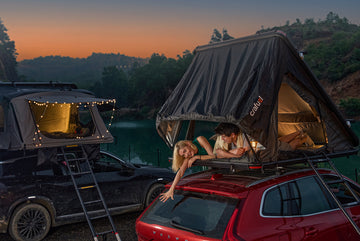What you should know to choose your first real-time regression therapy (RTT) as a beginner?
by Laine Ye on Aug 12, 2023

The benefits of using a rooftop tent for camping.
Are you tired of traditional camping tents that take forever to set up and leave you cramped? Look no further than a rooftop tent for your next camping adventure.
Rooftop tents are a portable shelter mounted on the roof of your vehicle or on a roof rack system. They have become increasingly popular among campers, adventurers, and outdoor enthusiasts due to their many benefits.
One of the biggest benefits of using a rooftop tent is the extra storage space it provides. By pitching your tent on the roof, you free up valuable storage space inside your vehicle. This allows you to better organize your gear without blocking rear view or blind spots.
Rooftop tents are also incredibly versatile. They can go anywhere your car can go, making them perfect for overlanding and scattered camping. Unlike traditional camping trailers or bulky RVs, Crafuel rooftop tents are easy to maneuver and can be set up in minutes.
Another benefit of using a rooftop tent is its ability to bridge the gap between a traditional tent and an RV. Rooftop tents offer more comfort than traditional tents while providing an authentic outdoor experience. They also offer better protection against wildlife and insects than ground level tents.
Finally, rooftop tents are perfect for all weather conditions. They are designed to withstand inclement weather such as rain, wind and snow. Many models have built-in insulation to keep you warm on cold nights.
In conclusion, if you're looking for a comfortable and convenient way to camp outdoors, consider investing in a rooftop tent. With their extra storage space, versatility, comfort, wildlife and insect protection, and ability to withstand harsh weather conditions, they are sure to make your next camping trip one to remember.
How do I properly install a rooftop tent on my vehicle?The process of installing a rooftop tent will vary depending on the specific model and type of vehicle you have . However, here are some general steps you can take to ensure proper installation:
- Choose the right roof rack: Before setting up your roof tent, make sure you have a strong and reliable roof rack that is compatible with your vehicle. The roof rack must be able to support the weight of the tent and occupants.
- Position the tent: Once your roof rack is in place, position the tent on it. Make sure it is centered and aligned correctly.
- Attach mounting brackets: Most rooftop tents come with mounting brackets that attach to the roof rack. Use these brackets to secure the tent to the rack, making sure to tighten them firmly.
- Test the stability: Once your tent is erected, test its stability by shaking it slightly from side to side and back and forth. If it seems loose or unstable, adjust the mounting brackets until it is secure.
- Install additional accessories: Depending on the specific model of your rooftop tent, you may need to install additional accessories such as a ladder or rain cover. Carefully follow the manufacturer's instructions when installing these accessories.
- Check for leaks: After installation, check for leaks by spraying water on the tent and checking for areas where water could seep. It is important to note that these are general guidelines and you should always refer to your specific model instructions when fitting a roof top tent to your vehicle. If you are unsure about any aspect of the installation, contact a professional for assistance.(info@crafuel.com)
Do I need something to go with a rooftop tent?
When it comes to camping in a rooftop tent (RTT), there are different approaches you can take depending on the experience you are looking for. Whether you're a minimalist or maximalist camper, there are a few essentials you should always pack to cover your basic needs.
First, check the weather forecast and pack appropriate clothing and toiletries such as insect repellent and sunscreen. Lights are also important for safety and convenience, so don't forget to pack flashlights, lanterns or headlamps.
Also, not all campgrounds will have basic amenities like running water or garbage disposal stations, so be prepared with 1 liter of water per person per day, bags trash and recycling, as well as toiletries and hygiene items suitable for your campsite. For those who want to take their camping experience to the next level, consider adding accessories such as a shelter annex or racks to keep essentials within reach and out of your bed.

